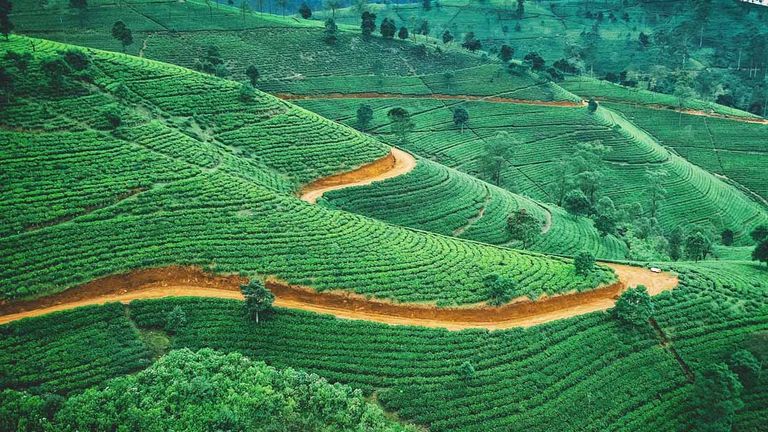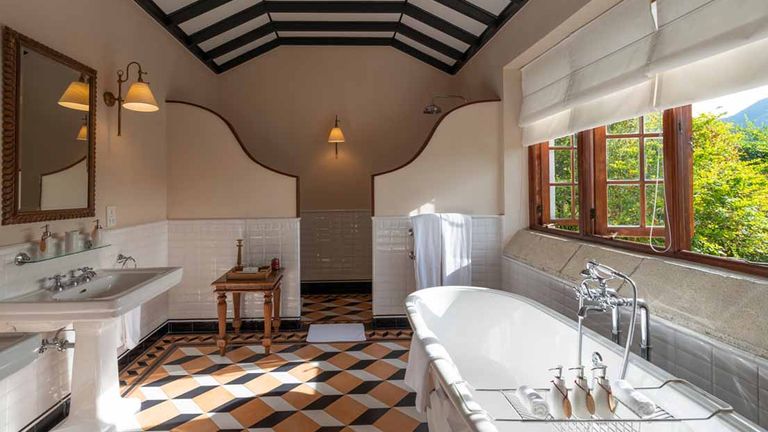We had been in Sri Lanka for almost two weeks and were ready for a break from the temples, crowds, congestion and chaos — we needed some “time out.”
The train station in the city of Kandy was quiet, almost deserted. We purchased our tickets and sat waiting on the platform, bags at our feet. We were early for the train.
A brilliant-green forest lizard perched motionless on top of the platform’s glass-encased Buddhist shrine. Little by little, more passengers began to arrive, filling the platform’s empty benches and tending to their luggage until the train pulled into the station.
Before we had left home, my Instagram feed had been full of travelers in Sri Lanka leaning out of a bright blue train, gazing at vibrant green tea plantations. And now, here we were, on the very same train.
 Sri Lanka is the fourth-largest tea producer in the world.
Sri Lanka is the fourth-largest tea producer in the world.
Credit: 2024 Jaromir KavanThe Hill Country rail route is arguably the most beautiful in Sri Lanka, and it is often named among the prettiest train journeys in the world, as well. The bright blue train passes through tea plantations, with curtains of eucalyptus and pine trees on one side and mountains and towering ravines on the other.
Hugging the hillside, the train trundled through tiny rural stations. Travelers and locals alike swung out the open doors, catching the breeze and posing for selfies while vendors passed through the carriage offering samosas and snacks. We climbed off at Hatton station and were then whisked into the world of tea.
What To Expect at the Ceylon Tea Trails
Sri Lanka is home to some of the finest tea plantations, which in turn produce some of the finest teas in the world. Tea is Sri Lanka’s most prolific export, in fact — accounting for 17% of the country's exports — and it dates back to colonial times, when well-known tea manufacturers began their legacy. Since the first tea bush was planted here in 1867, Sri Lanka has become the fourth-largest tea producer in the world, creating an industry that employs more than 1 million people and contributes $1.3 billion to the country’s economy each year.
Bogawantalawa is a remote corner of Sri Lanka and one that relatively few travelers venture to. It’s here you’ll find the exclusive Ceylon Tea Trails, a collection of five restored colonial bungalows and the only Sri Lankan member of the prestigious Relais & Chateaux association.
Overlooking Castlereagh Reservoir and surrounded by stunning terraced tea plantations, the tranquil estate feels completely detached from the hustle and bustle of the outside world. Located on the estate of the renowned Dilmah tea company, Ceylon Tea Trails is fully inclusive of gourmet a la carte meals, beverages (including wines and spirits), laundry and tea experiences.
 Guestrooms reflect the property’s history with their design.
Guestrooms reflect the property’s history with their design.
Credit: 2024 Ceylon Tea Trails ResortThe bungalows at Ceylon Tea Trails feature manicured gardens of roses, lilies, dahlias and more, and each has a pool, croquet lawn and wicker chairs where clients can sit and enjoy the breathtaking views. Every bungalow offers a unique vibe that reflects its history, with the oldest one, named Tientsin, dating back to 1888.
The more modern Dunkeld Bungalow offers an outdoor infinity pool with a bubbling hot tub, as well as a standalone Owner's Cottage, a private and romantic one-bedroom residence.
 A bathroom at Ceylon Tea Trails
A bathroom at Ceylon Tea Trails
Credit: 2024 Ceylon Tea Trails ResortInside, the charming bungalows hark back to the property’s colonial past and character, with muted colors, antique prints and maps, huge four-poster beds, free-standing claw-foot bathtubs and Persian carpets. Some rooms have fireplaces for cooler evenings, and many bungalows come with private gardens. Each accommodation has its own chef and butler. (There are no televisions in rooms, in hopes of helping guests escape from modern life, but the staff will set one up for any visitor who must have the device).
Tea Tours and More at Ceylon Tea Trails
Guests can kayak in the reservoir, play tennis on the resort’s clay court and enjoy leisurely walks through the tea plantations, where they are sure to observe tea-pickers collecting leaves. An absolute must for clients is the resort’s tea factory tour, during which participants learn about the ancient process of making tea.
We started our tour among the tea bushes themselves. After just a few minutes of walking, we had already discussed the history of tea, different methods of tea picking and how the future of this physically demanding work may be impacted in a world of increasing mechanization.
Leaning in, I inspected the bright-green buds of the tea bushes. Only the top two or three leaves are plucked from the bush, and as I gazed down the valley over the many hundreds and thousands of bushes blooming below, my mind began to reel.
We then entered the doors of the weather-beaten tea factory, and the first thing that hit me was the pungent aroma of drying tea, followed by the heat and noise. The sounds of huge dryers pushing warm air and the crashing sound of machines filled the air. We passed freshly picked leaves lying on the “withering racks.” Next, as part of the maceration process, the leaves are torn and lightly bruised to trigger oxidation.
Fermentation comes next, during which the leaves are left to dry and darken; the process breaks down the chlorophyll and releases the tannins that give tea its taste. Lastly, heat is used to stop the oxidization, before the leaves are rolled, shaped and dried one final time.
Finally, the tea is sifted through mesh of various sizes, with the larger leaves being the best and finest. Seeing the whole process like this, I realize how much work has gone into the thousands of cups of tea I have enjoyed in my life.
Once the tour was over, we left the heat of the factory and climbed into an open-sided jeep. We bounced along the dirt road as our driver navigated narrow curves and hairpin bends. When we came to a stop, we disembarked and found a surprise: spread out in front of us was a long table, complete with a tablecloth, cutlery and an array of glasses, all shaded by a pair of umbrellas. It was a picnic like no other.
A chef manned a barbecue while two waiters in crisp white shirts poured us drinks. In the fields below us, the tea pickers toiled, tossing emerald leaves into sacks on their backs and pausing to shout out a hello and wave. All around us was a sea of green.
Need-to-Know Details
When to Go
Ceylon Tea Trails is a year-round destination, and because it's so high up in elevation, it rarely gets unbearably hot. December through April is usually the best time to visit — it’s the driest time of the year, and temperatures generally don’t exceed around 82 degrees during the day.
How to Get There
Ceylon Tea Trails is about 4.5 hours from Colombo by car (private transfers can be arranged) or 30 minutes by air. Cinnamon Air offers seaplane flights that land on the Castlereagh Reservoir; this is highly recommended, as it saves time, avoids winding mountain roads and has spectacular views. Kandy is 2.5 hours away by car.